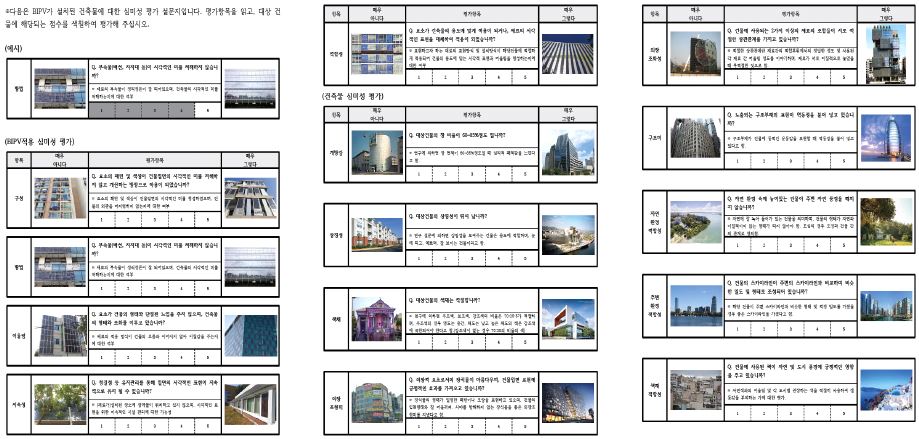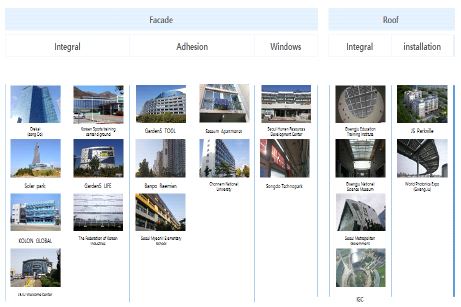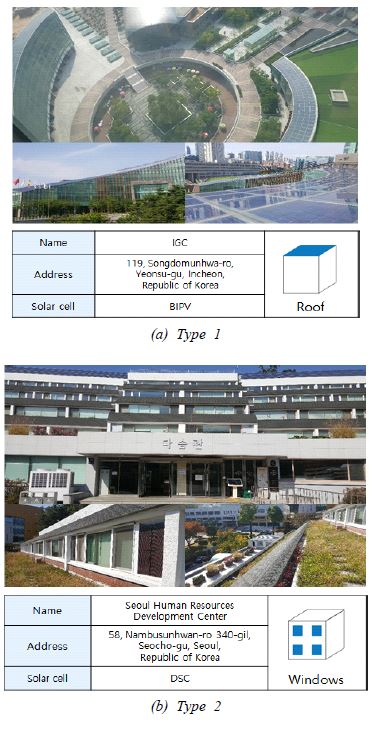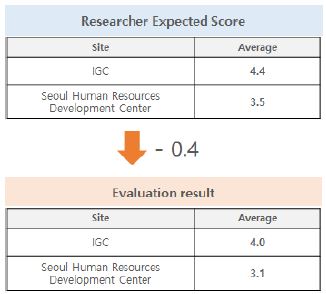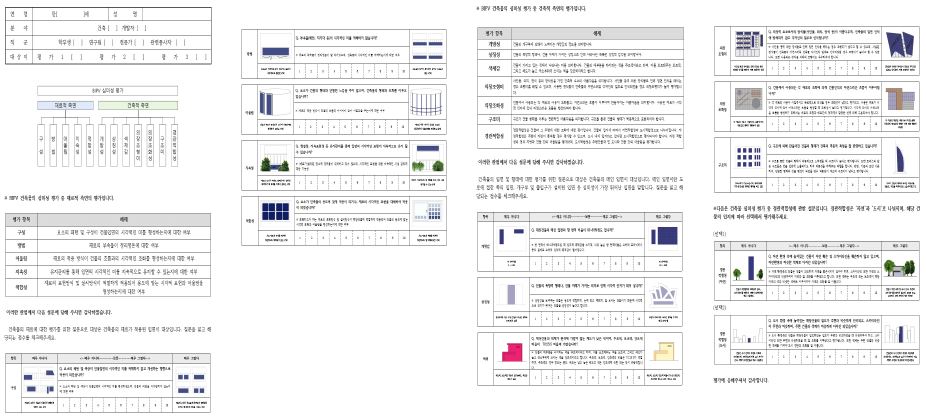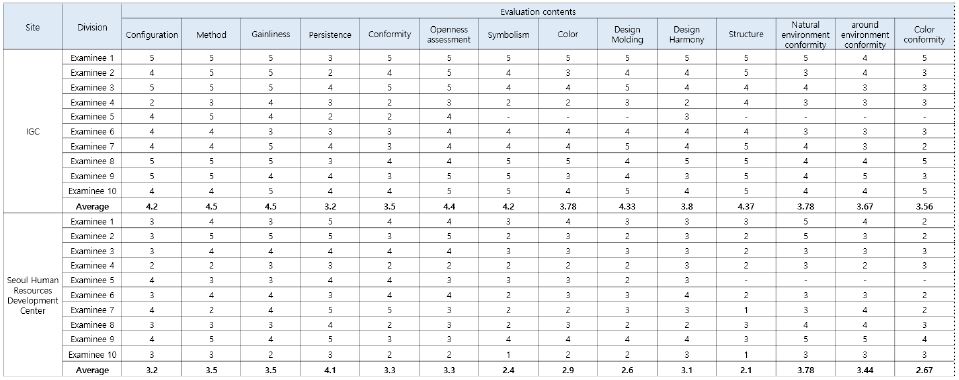
건물일체형 태양전지 적용 건축물의 심미성 평가체계 구축
ⓒCopyright Korea Institute of Ecological Architecture and Environment
Abstract
The global warming problem becomes serious and sustained attention of renewable energy is being done to solve the energy problem. Among new and renewable energies, the market for solar cells that can be easily solved in our daily life is increasing more and more. Modules capable of adjusting transparency and expressing colors are developed for current solar cells, and various design expressions have become possible in the facade view of the building. However, some experts focused on energy performance, and systems such as the form, color, light transmission, and integrity of solar cells are not established. Therefore, this study intends to study the integrated guideline of the architectural facade by analyzing and presenting the evaluation system for the aesthetic purpose of the solar cells.
To derive the evaluation factor of esthetics, derive primary elements through analysis of advanced research and case analysis of BIPV buildings.
There are 50 aesthetic elements derived predominantly from advanced research and BIPV cases or analyzes. However, after three processes with emphasis on the possibility of evaluation, the aesthetic evaluation factor of the finally derived BIPV building is 12 elements.
Keywords:
Elevational Aesthetics, BIPV (Building Integrated Photovoltaics), Building Facade, Renewable Energy키워드:
입면 심미성, 건물일체형 태양광발전, 건축외피, 신재생에너지1. 서론
현재 지구온난화 문제가 심각해지면서 에너지 문제를 해결하기 위해 신재생에너지에 대한 지속적인 관심이 이루어지고 있다. 신·재생에너지 중 우리 일상에서 손쉽게 해결할 수 있는 태양전지 시장이 확대되어 가고 있으며, 이에 따라, 태양전지 적용 건축물의 비중이 점점 증가하고 있는 추세이다.
태양전지는 현재 3세대 태양전지까지 기술이 개발된 상황으로서 불투명하고 단색으로 표현되는 모듈에서 다양한 색상표현과 투명도 조절이 가능한 모듈이 개발되고 있다. 아울러 다방면으로 적용이 가능하도록 적용위치 및 방식이 다양하게 변해가고 있다. 하지만, 대부분의 연구가 에너지성능을 중심으로 진행되며, 시공은 일부 전문가에 의해 적용되고 있다. 따라서 형태, 색채, 투광성 및 일체성 등 디자인과 심미성에 대한 정성적인 부분에 대한 연구가 추가적으로 필요한 상황이다.
이 연구는 건축물의 계획 및 설계 과정에서 채택 가능한 태양전지의 특성을 분석하고 심미성을 발현할 수 있는 태양전지 적용성 평가 방법을 제시하는 것에 목적이 있다. 건축물의 심미성 평가를 위한 평가시스템에 대한 분석을 진행하며, 주요 요소를 도출하고 평가지표를 구축함으로써 평가시스템 수립을 위한 기초자료를 제시하고자한다.
2. 이론적 고찰
2.1. 신․재생에너지의 현황
신·재생에너지는 현재 문제되고 있는 화석연료를 대체 하며, 지속적인 사용이 가능하며 자연을 이용한 에너지로 녹색성장으로 인한 잠재력이 높다. 현재 우리나라는 신·재생 에너지를 12개 분야로 구분하고 있으며, 수소에너지, 연료전지, 석탄가스화·액화, 태양광, 태양열, 바이오, 풍력, 수력, 해양, 폐기물, 지열 및 수열로 구분된다.1)
2.2. 태양전지 종류
태양전지는 1세대 결정질 실리콘 태양전지, 2세대 박막형 태양전지, 3세대 염료감응형 태양전지로 나누어 볼 수 있다.
▪ 1세대 : 결정질 실리콘 태양전지
우리나라에 가장 많이 적용되는 방식으로 별도의 부속물을 이용하여 적용하며, 별도의 부지나 건물의 지붕에 주로 설치된다. 결정질 실리콘 태양전지는 반도체 실리콘 웨이퍼로 만들어 졌으며, 불투명한 어두운 청색을 띠기 때문에 외부 조망과의 간섭으로 적용범위가 제한적이다.
▪ 2세대 : 박막형 태양전지
1세대 태양전지와 달리 반도체 실리콘 혹은 화합물 반도체를 저가의 기판에 박막 형태로 코팅한 방식이다. 코팅된 반도체 박막의 두께에 따라 투광도 조절이 가능하고, 얇고 유연한 기판을 이용하면 곡면에도 적용가능하다. 또한, 박막형 태양전지는 건물일체형 태양광발전(Building Integrated Photovoltaic, 이하 BIPV)에 주로 사용되는 방식이며, 대표적 유형으로는 건물의 지붕, 외벽, 차양장치가 있으며, 유형에 따라 적용방식이 다양하다.
▪ 3세대 : 염료감응형 태양전지
광합성 원리를 응용하여 개발된 태양전지로 빛을 흡수하는 염료가 흡착된 반도체 나노입자들로 이루어진 막을 기판에 코팅한 방식이다. 사용되는 염료의 색깔에 따라 다채로운 색상표현이 가능하고, 반도체 나노입자의 크기 및 막의 두께 등으로 투광도를 조절할 수 있어 창호에 적용가능하다. 또한 친환경적인 산화물 반도체를 사용하고, 유연한 기판을 이용하면 건물의 곡면에도 적용가능하다.
2.3. 태양전지 적용 건축물의 고려요소
태양전지는 태양빛으로 전기를 생산하는 장치로 효율성 부분이 우선적으로 고려되어야 한다. 이러한 부분을 선행연구를 통하여 분석을 실시하며, 태양전지 재료 자체의 특성을 고려한 심미성 평가지표를 구축하고자 한다.
태양전지의 효율성을 높이기 위해서는 경사와 방위각, 음영, 온도가 가장 기본적인 고려해야 할 요소이며, 추가적으로 설비, 에너지, 접근성·유지성 등이 고려되어야 한다. 이러한 부분을 고려하기 위해서는 태양광발전 모듈의 종류에 따른 특성을 이해하고, 이를 건축에 적용하기 전에 주요 요소를 검토하는 방안이 필요하다. 특히, 적용하고자하는 건물을 대상으로 에너지 성능에 대한 시뮬레이션을 진행하여 1차적으로 적용 위치를 설정하여야하며, 이를 기반으로 디자인 특성을 적용할 수 있도록 통합적인 체계가 필요하다.
이 연구에서는 기술적인 문제 외에 건물의 재료로 적용되는 태양전지의 의장적 역할 및 건물과의 조화에 중점을 두어 연구하고자 한다. 따라서, 기술성이 아닌 심미성을 중심으로 BIPV에 대해 접근하며, 태양전지의 특성을 고려한 심미성에 대한 분석을 실시하고자 한다.
3. 평가요소 도출
이 연구에서 다루고자 하는 태양전지 적용 건축물의 범위는 태양전지가 건축입면에 적용된 비중이 높은 BIPV 시스템을 중심으로 진행하였다. 또한, 건축물을 외부에서 바라보았을 때를 기준으로 설정하여 연구를 진행하였으며, 이는 태양전지가 적용된 건축물은 주로 시선이 외관에 집중되며, 내부에서는 태양전지가 이용자에게 직접적으로 노출되는 사례가 적기 때문이다. 연구의 방법은 아래와 같다.
첫 째, 선행연구와 사례분석을 통해 태양전지 적용 건축물의 통합적인 디자인 요소를 분석한다. 태양전지 측면에서는 에너지성능 및 효율성에 대한 부분은 제외하고 디자인 요소만 분석하였으며, 건축적인 측면에서는 건축입면 및 도시의 디자인 요소로 유형화하여 분석함으로써 통합적인 심미성 평가요소를 도출하는 과정이 진행된다.
둘 째, 태양전지 적용 건축물의 적용방식, 적용위치, 높이에 대한 분석을 실시하여, 건물의 용도에 따른 유형화가 진행된다. 또한, 추가적으로 유형별 특성을 분석하여 유형별 미관적 특성을 고려한 평가지표가 구축된다.
셋 째, 평가하고자 하는 항목에 대한 기준과 이를 어떠한 관점에서 평가하고 분석할 것인지에 대한 기준을 구체적으로 기준, 질문 및 해제가 설정된다.
넷 째, 구축된 평가지표를 기반으로 평가 가능성 및 평가 요소로서의 적정성에 대한 분석이 실시되며, 이러한 분석을 통하여 도출된 요소의 적정성 및 일관성에 부분에 대한 평가가 진행된다.
다섯 째, 평가대상지의 태양전지 적용 건축물에 평가시스템을 적용하여 심미성 평가 및 개선사항에 대한 분석이 진행된다. 추가적으로 평가지표에 대한 설명 자료를 인쇄물을 활용하여 제공함으로써 평가자들이 평가항목에 대한 이해에 도움을 주는 것이 목적이다.
여섯 째, 종합적인 데이터를 분석하여 태양전지 적용건축물의 심미적 적용방안에 대해 제안하며, 나아가 태양전지 적용 건축물의 개선사항이 제시된다.
3.1. 태양전지 시스템의 유형
태양전지는 주로 태양 빛이 비춰지는 장소에 적용이 가능하며, 건축물의 입면부분에 다양한 방식으로 적용될 수 있다. 입면에 적용되는 태양전지는 적용위치에 따라 수직면, 상부 수평면, 기타로 분류 할 수 있으며, 적용위치에 따라 형성되는 미관적 특성은 다음과 같다.
▪ 수직면
수직면은 건물의 벽면에 태양전지가 적용된 경우를 의미한다. 건물의 미관적인 부분에 영향을 많이 주는 방식으로 적용방법으로는 매립부착형, 일체형, 창호형이 있다. 주로 커튼월로 적용되는 방식과 마감재로 적용되는 방식이 있으나 커튼월은 설계시부터 고려해야한다는 점이 있기 때문에 신축건물에 많이 적용되며, 매립부착형 및 차양장치는 기존건물에 리모델링을 통해 적용되는 사례가 많다. 신·재생에너지센터의 시공규정을 살펴보면, BIPV는 창호, 스팬드럴, 커튼월, 이중파사드, 외벽, 지붕재 등 건축물을 둘러싸는 벽, 창, 지붕 형태로 시공을 제한하는 규정이 있다.
▪ 상부면
상부면은 건축물의 지붕에 적용된 경우를 의미한다. 경사지붕, 평지붕 및 톱니지붕으로 유형화 할 수 있으며, 채광효과를 줄 수 있는 아트리움 지붕 및 천창에 반투명한 태양전지를 사용하여 실내에 채광성 유지 및 차양의 기능 등을 할 수 있다. 또한, 수직 파사드에 비해 건물의 미관적인 부분에 미치는 영향이 적으며, 주로 건물의 로비에 적용이 된다.
▪ 기타
차양장치 또는 발코니에 설치된 경우를 의미한다. 차양장치는 고정형과 가동형으로 나눠질 수 있으며, 차양장치의 형태와 적용되는 태양전지에 따라 실내공간의 채광에 영향을 주며, 태양전지 외에 적용되는 부속물로 인해 건축물의 미관형성에 영향을 줄 수 있다.
3.2. 건축입면의 심미성 특성 분석
건축입면에 대한 선행연구를 2가지 유형으로 나누어 분석하였다. 경관적 관점과 건축적 관점으로 유형을 나누며, 심미성 요소는 선행연구의 분석을 통해 도출되는 요소의 빈도분석을 통해 1차적인 요소를 도출하였다. 연구의 범위는 건축물의 형태에 대한 심미성에중점을 두어 분석하였으며, 경관적 관점에서 분석되는 이용자에 대한 편의성 및 장소성 등과 같은 요소는 심미성 요소와 관계성이 낮다고 판단하였으며, 요소도출 과정에서 제외하였다.
먼저, 건축적인 관점은 건물자체가 가지는 조형적인 아름다움을 의미하며, 경관적 관점은 건물이 주변과 어우러져 조성하는 분위기적 아름다움을 의미한다. 건축적 관점의 선행연구를 분석하면, 도시의 부분까지 포함하고 있는 연구가 많았으며, 건축물의 가장 기본적인 요소를 도출하여 모든 건축물을 공통적으로 평가할 수 있도록 하였다. 경관적 관점의 요소 도출과정은 건축적 관점과 동일하며, 추가적으로 심미성 평가요소에 대한 적합성 여부에 대한 분석을 진행하였다.
분석방법은 1차적으로 선행연구의 빈도분석을 통해 주요요소를 도출하고, 분석된 요소 중 유사한 의미와 중복되는 평가범위를 가지고 있는 요소를 중심으로 요소를 결합하고 제외하는 과정을 진행하였다.
3.3. 태양전지의 심미성 특성 분석
태양전지에 대한 선행연구를 중심으로 태양전지 적용 건축물의 심미성 요소를 분석하였으며, 태양전지는 2가지의 유형으로 나누어 분석을 진행하였다. 재료의 특성과 설치유형의 특성으로 나누어 분석하였다. 재료의 특성은 선행연구를 기반으로 분석을 진행하였으며, 설치유형의 특성은 선행연구와 현장답사를 통해 요소를 도출하였다.
재료적 특성은 재료가 표현할 수 있는 심미성 요소를 의미한다. 분석유형은 건물일체형으로 사용되는 BIPV와 DSC를 분리하여 분석하였으며, 분석내용은 재료에 따른 특성에 따른 표현성 및 성질에 대한 심미성 요소를 파악하였다. 또한, 설치유형으로 인해 표현될 수 있는 심미성 요소를 분석하여 유형별 주요 특성을 도출하였다.
선행연구의 요소에 대한 빈도분석을 진행한 결과, BIPV 디자인 요소는 1차적으로 색상, 형태, 모듈, 조화성, 건물과의 일체성이 도출되었으며, DSC 디자인 요소는 선행연구를 통해 투광성 및 색상 요소가 도출되었다. 투광성은 조망상태를 의미하는 요소지만, 세부적인 요소 중 물리적인 요소가 포함되어 있어, 이를 제외하고 미관적 요소만 도출하였다.
통합적인 태양전지의 요소는 색상, 형태, 건물과의 일체성, 투과성 총 4개의 요소이다. BIPV와 DSC 태양전지에서 공통적으로 분석된 요소는 색상이며, 요소에 대한 용어 및 설명은 Table 4를 통해 설명하였으며, BIPV와 DSC 태양전지의 요소를 통합시킨 소분류 항목은 Table 5와 같다.
4. 평가시스템 개발
4.1. 심미성 평가항목 통합
건축입면과 태양전지 심미성 요소를 통합하는 과정에서 중요하게 생각하여야 하는 부분은 평가범위에 대한 통합이다. 건축입면은 건축물에 대한 평가부터 건축물과 주변경관에 대한 평가를 하는 범위로 태양전지 심미성 요소보다 평가 범위가 크지만 세부적이지 않다.
요소를 통합하기 위하여 1차적으로 선행연구를 통해 도출된 50개의 요소를 가지고 중복되는 의미의 요소는 결합하고 태양전지 적용 건축물의 해당되지 않는 요소는 제외하며, 용어를 건축적 용어로 정리하는 과정을 진행하였다.
이러한 과정으로 도출된 24개의 요소를 평가범위를 기준으로 2차적인 분류를 진행하였다. 건축입면의 요소와 태양전지의 요소를 분리하는 방식을 통하여 요소를 통합하였으며, 단거리, 중거리, 원거리의 개념을 이용하여 재료적 측면, 건축적 측면, 도시적 측면으로 평가범위에 분류를 진행하였다. 3차적인 분류는 도출된 24개의 요소를 기반으로 현장평가를 진행하였으며, 평가 가능성에 대한 검증을 실시하였다.
평가대상지는 서울에 있는 BIPV 사례지 8곳을 대상으로 진행하였으며, 선정된 대상지는 설치유형별 대표 사례지로 선정하여 진행하였다. 현장평가를 통하여 평가 가능성을 중점으로 항목을 수정하였으며, 객관적인 평가가 불가능한 요소는 제외하며, 중복되는 범위의 평가요소는 결합하는 과정이 진행되었다. 추가적으로 명확한 의사전달을 위한 평가요소의 평가질문 및 해제를 재수정하는 과정을 진행하였다.
1차적으로 50개의 항목에서 3번의 과정을 거쳐 최종적으로 14개의 항목이 도출되었다. 도출된 항목에 대한 기준, 질문, 해제를 설정하였으며, 요소에 대한 구체적인 평가기준은 Table 7과 같다.
4.2. 모의평가진행
태양전지 적용 건축물의 심미성 평가요소는 선행연구와 사례지 분석을 통해 최종적으로 14개의 요소가 도출되었으나, 건축관련 대상자를 통해 평가지표로서의 타당성과 평가가능성에 대한 부분을 추가적으로 분석하였다.
1차적으로 태양전지 설치유형별 BIPV 사례지를 분석하였으며, 이 연구에서 설정한 유형을 기반으로 각 유형별 대표 대상지를 선정하여 BIPV 모의평가 대상지 20곳을 선정하였다.
선정된 평가대상지는 2번의 평가에 거쳐 구축된 평가지표에 대한 적합성 평가를 진행하였다. 평가방법은 사진을 이용하여 대상지를 평가하며, 평가 설문지는 Fig. 2의 건물 사례 안내서를 사용하여 구축된 평가요소에 대한 평가 가능성과 평가 지표로서의 적합성을 중점에 두고 분석을 진행하였다.
이렇게 분석된 점수를 기반으로 모의평가 대상지를 선정하였으며, 이를 대상으로 모의평가를 실시하였다. 모의평가를 통해 분석하고자 하는 내용은 평가대상지에 평가시스템을 적용하였을 때 연구자가 예상하는 점수와 제3자가 평가한 점수에 대한 비교분석을 진행하고자 한다. 모의평가 대상지는 적합성 평가를 통해 얻어진 점수를 통해 선정하였으며, 중간 점수의 대상지와 가장 높은 점수의 대상지를 선정하였다. 선정된 대상지의 구체적인 사항은 Fig. 3과 같다.
모의평가는 건축 관련 대상자가 평가시스템을 가지고 대상지를 평가하는 것으로 진행되었다. 평가방법은 사진을 이용한 설문조사로 시간제약은 따로 하지 않았으며, 평가 설문지는 14개 요소에 대한 심미성 평가를 진행하는 것으로 진행되었다. 분석방법은 의미 분화법인 SD(Semantic Difference)법을 기반으로 실시되었으며, 평가대상자는 건축전공 관련 연구원 10명으로 진행되었다.
모의평가를 통해 분석하고자 하는 내용은 평가시스템을 통해 평가한 BIPV 건축물의 심미성 점수와 평가시스템의 개선사항이다. 두 건물에 대한 종합적인 BIPV 건축물의 심미성 점수의 평가 집계는 Table 8과 같다.
4.3. 소결
평가시스템을 통하여 평가대상지를 분석한 결과, 연구자가 예상하는 점수와 제3자가 평가한 점수 결과는 두 대상지 모두 예상했던 점수보다 0.4점 낮게 평가되었다.
이러한 부분을 분석해보면 일정한 항목에서는 객관적이고 일관적인 평가가 가능하지만, 어떠한 항목에서는 평가자에 따라 점수 차이가 크게 차이나며 일관적인 평가가 불가능 하다는 것을 확인할 수 있었다.
평가대상자가 바라본 평가시스템의 개선사항으로는 평가범위, 즉 공간적 범위에 대한 명확한 제한이 필요하며, BIPV에 대한 이해를 도울 수 있는 참고자료가 함께 제공되어야 할 것이라는 의견이 있었다. 또한, 평가하고자 하는 것에 대해 평가기준 및 질문을 구체적으로 기술하여 평가대상자가 일관적인 평가를 할 수 있도록 유도하는 것이 필요할 것 같다는 의견이 있었다.
이러한 분석결과를 바탕으로 중복 평가되는 요소와 객관적인 평가가 불가능한 항목을 재검토 및 재분류를 실시하였다. 특히, 평가 범위에 대한 명확한 설정이 필요한 경관적 특성에 대한 분류를 중점으로 진행하였다. 기존의 경관적 특성은 총 3개의 항목으로 분류되어 있었다. 자연 환경 적합성, 주변 환경 적합성, 색채 적합성으로 분류되어 있었으나, 건물이 위치한 대지의 상황에 따라 평가 불가능한 항목이 발생되었다.
도시 속에 위치한 건물은 자연 환경 적합성에 대한 평가가 불가능하였고, 자연 속에 위치한 건물은 주변 환경 적합성에 대한 평가가 불가능하였다. 따라서, 이를 고려하여 건물 대지의 상황에 따라 평가 요소를 선택하여 평가 할 수 있도록 요소를 통합하였다. 최종적으로 도출되는 요소 및 질문은 아래와 같다.
이 연구의 소결로서 최종적으로 도출된 요소를 정의, 해제 및 평가기준 등을 설정하여 구축된 평가 설문지는 Fig. 5와 같다.
5. 결론
태양전지 자체의 특성을 고려한 심미성 평가체계를 구축하기 위해 진행된 연구는 다음과 같다.
첫 째, 태양전지에 대한 재료적인 특성을 이해하고, 이를 기반으로 태양전지 적용건축물을 유형화 하였다. 이 연구에서는 적용위치에 따른 유형을 대표적인 유형으로 설정하였으며, 적용위치에 따른 미관적 특성을 분석하였다. BIPV 건축물은 수직면(외벽), 상부면(지붕) 및 기타(차양장치)로 유형화 할 수 있다.
둘 째, 태양전지 특성과 건축적 특성으로 분리하여 심미성 요소를 도출한 결과 1차적으로 50개의 요소가 도출되었으며, 3번의 재분류과정을 진행하여 최종적으로 14개의 요소가 도출되었다.
셋 째, 모의평가를 통해 평가시스템을 분석한 결과, 일정한 부분에 대해서는 일관적인 평가가 가능하였지만, 일정한 부분은 일관적인 평가가 불가능하였다. 특히, 경관적 특성는 건물 대지의 상황에 따라 평가 불가능한 요소가 있었으며, 이러한 부분을 고려하여 평가 요소에 대한 재분류를 진행하였다.
넷 째, 일관적인 평가 가능성을 중점으로 요소를 재분류한 결과 경관적인 특성에 대한 부분을 하나의 항목으로 통합하였으며, 각 건물(대지)의 상황에 따라 선택하여 평가 할 수 있도록 평가시스템을 수정하였다. 따라서, BIPV 건물의 심미성 평가요소는 최종적으로 12개의 요소가 도출되었다.
이 연구는 추후 평가요소에 대한 AHP 중요도 평가를 진행하며, AHP (Analytical Hierarchy Process) 평가를 통해서 평가요소들간의 우선순위를 분석하여 요소의 가중치를 설정한 평가시스템 구축을 진행하고자 하며, 현재 심미성 등 디자인 속성이 상세하게 반영된 표준형 BIM (Building Information Modeling) 라이브러리 구축 연구를 병행하고 있다.
Acknowledgments
This research was supported by a grant from Land and Transport Technology Promotion Research Program (Implementation of Building Façade Modules Based on Colorful Semi-transparent Solar Cells towards Urban Surroundings) funded by Ministry of Land and Transport Affairs of Korean Government (Project No.: 17CTAP-C129910-01).
Notes
References
-
윤성훈, “태양광발전시스템의 공공디자인적 요소에 관한 연구 : 일반건축/공동주택/공공시설물 등을 중심으로”, 한양대학교, (2013).
Yun, Sung-Hun, Studying the Factors of Photovoltaic Power Generation System in the Public Design Area, Hanyang University, (2013). -
이기원, “교육시설에서의 DSC BIPV 창호를 통한 에너지 증감 분석 연구”, 세명대학교, (2016).
Lee, Ki-Won, “A Study on the Energy decrease Analysis with DSC BIPV windows in educational facilities”, Semyung University, (2016). -
양희범, “BIPV시스템의 건물 외관 디자인 적용 방법에 관한 연구 : 송도테크노파크 자동차 부품센터를 중심으로”, 연세대학교, (2009).
Yang, Hee-Bum, “A study on the application of the BIPV system in building skin design : focused on the Songdo-technopark automobile parts center”, Yonsei University, (2009). -
한재경, “환경 친화적 공동주택 태양광 적용 디자인 계획에 관한 연구”, 동국대학교, (2010).
Han, Jae-Kyung, “A Study on Architectural Design Application of Photovoltaic System in Environment-Friendly Housing”, Dongguk University, (2010). -
김재웅, “건축물일체형 BIPV시스템의 효율성 개선방안에 관한 연구”, 서울시립대학교, (2012).
Kim, Jae-Woong, “A Study on Efficiency Improvement plan to the BIPV system of adhesion method on the Building”, University of Seoul, (2012). -
홍선표, “도시맥락을 위한 건축입면의 인지요소 순위 결정 및 비교”, 충북대학교, (2013).
Hong, Seon-Pyo, “Determination and Comparison of Cognitive Priority for Building Elevation within Urban Context”, Chungbuk National Universit, (2013). -
이소민, “디자인서울거리의 가로특성별 유형에 따른 평가지표 설정에 관한 연구”, 한양대학교, (2010).
Lee, So-Min, “A study on the establishment of evaluation indicators by classification for street characteristics of Design Seoul Street Projects”, Hanyang University, (2010). -
백승경, “생태적으로 지속가능한 공공공간 디자인 체크리스트에 관한 연구”, 홍익대학교, (2009).
Kim, Joo-Yun, “A Study on the Design Checklist for Ecologically Sustainable Public Space”, Hongik University, (2009). -
서지영, “상업건축 파사드 디자인 결정요소의 유형적 분석 연구”, 경상대학교, (2011).
Suh, Ji-Young, Typological Analysis on the Façade of Commercial Buildings, Gyeongsang National University, (2011). -
김승태, “사용자 관점의 아파트 입면디자인 요소의 중요도 및 요소별 디자인 선호도에 관한 연구”, 한양대학교, (2010).
Kim, Seung-Tae, “A Study on the Importance of Apartment Facade Design Elements and Design Preference of Each Element based on a User's Point of View”, Hanyang University, (2010).

